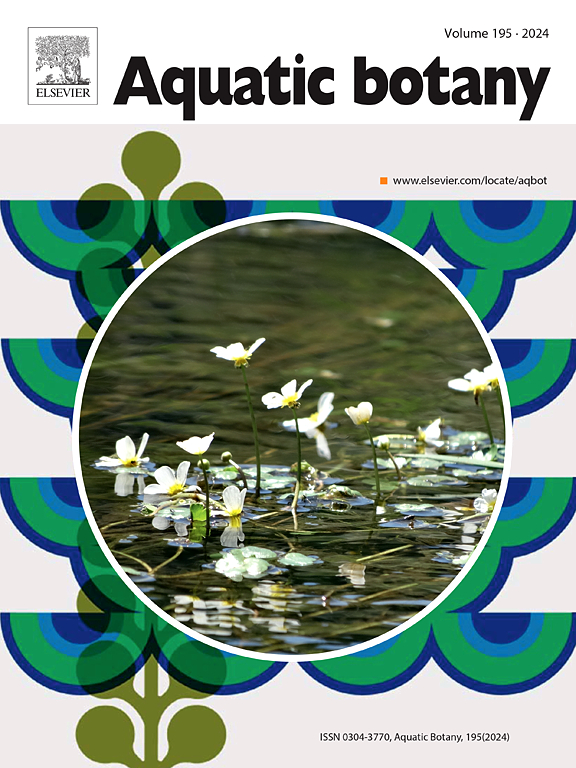An aquatic pteridophyte, Salvinia, from the Subathu Formation (Late Paleocene–Early Eocene) of Himachal Himalaya, India, and its biogeographical implications
IF 2.6
4区 生物学
Q2 MARINE & FRESHWATER BIOLOGY
引用次数: 0
Abstract
Salvinia, a free-floating aquatic, rootless fern, has a rich fossil record in Cenozoic sediments of Southeast Asia, Europe, and North-South America. However, none have been reported from the Cenozoic sediments of India, until now. Here, we report the occurrence of vegetative remains (both impressions and compressions), along with trichome bases, resembling both morphologically and anatomically those of the extant genus Salvinia Séguier from the Late Paleocene-Early Eocene of the Subathu Formation in the Mandi District of Himachal Pradesh, northwestern India. These newly discovered fossils are characterized by round, elliptical, or elongate fronds, with small hexagonal or quadrangular areolaes, usually 8–16 tubercles in a row between adjacent lateral veins, and craspedodromous lateral veins lacking marginal loops. Anatomically, epidermal cells are quadrangular or polygonal with diacytic stomata composed of two guard cells and numerous conical, filiform, slightly enlarged, and curved non-glandular trichomes. We describe these Eocene specimens as a new species, namely Salvinia indica A. Ali & M. A. Khan sp. nov. The discovery of this species suggests that the Eocene Subathu Formation represents sediments deposited in mostly calm freshwater bodies such as very low-energy meandering rivers, streams, or wetland ponds.
印度喜马偕尔-喜马拉雅地区Subathu组(古新世晚期-始新世早期)的水生蕨类植物Salvinia及其生物地理意义
Salvinia是一种自由漂浮的水生无根蕨类植物,在东南亚、欧洲和南北美洲的新生代沉积物中有丰富的化石记录。然而,到目前为止,还没有来自印度新生代沉积物的报道。在这里,我们报告了在印度西北部喜马偕尔邦曼迪地区的Subathu组的晚古新世-早始新世现存的Salvinia ssamuier属的形态和解剖学上类似的植物遗骸(包括印痕和压缩)以及毛状基底的出现。这些新发现的化石的特点是圆形、椭圆形或细长的叶子,有小的六边形或四边形的乳晕,相邻的侧脉之间通常有8-16个小结节排,以及没有边缘环的蔓生侧脉。解剖上,表皮细胞呈四边形或多角形,有双胞口,由两个保卫细胞和许多圆锥形、丝状、稍大、弯曲的非腺毛状体组成。我们将这些始新世标本描述为一个新种,即Salvinia indica a . Ali &;这一物种的发现表明始新世Subathu组的沉积物主要沉积在平静的淡水水体中,如能量极低的蜿蜒河流、溪流或湿地池塘。
本文章由计算机程序翻译,如有差异,请以英文原文为准。
求助全文
约1分钟内获得全文
求助全文
来源期刊

Aquatic Botany
生物-海洋与淡水生物学
CiteScore
3.80
自引率
5.60%
发文量
70
审稿时长
6 months
期刊介绍:
Aquatic Botany offers a platform for papers relevant to a broad international readership on fundamental and applied aspects of marine and freshwater macroscopic plants in a context of ecology or environmental biology. This includes molecular, biochemical and physiological aspects of macroscopic aquatic plants as well as the classification, structure, function, dynamics and ecological interactions in plant-dominated aquatic communities and ecosystems. It is an outlet for papers dealing with research on the consequences of disturbance and stressors (e.g. environmental fluctuations and climate change, pollution, grazing and pathogens), use and management of aquatic plants (plant production and decomposition, commercial harvest, plant control) and the conservation of aquatic plant communities (breeding, transplantation and restoration). Specialized publications on certain rare taxa or papers on aquatic macroscopic plants from under-represented regions in the world can also find their place, subject to editor evaluation. Studies on fungi or microalgae will remain outside the scope of Aquatic Botany.
 求助内容:
求助内容: 应助结果提醒方式:
应助结果提醒方式:


